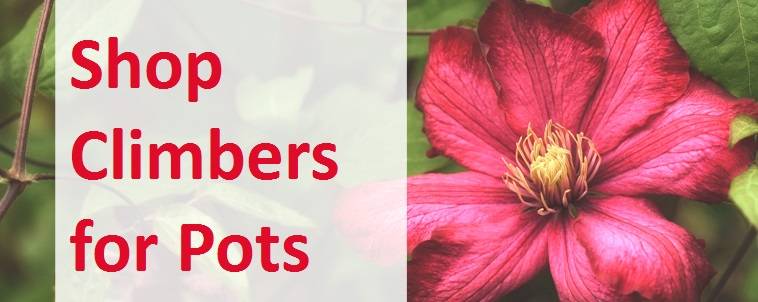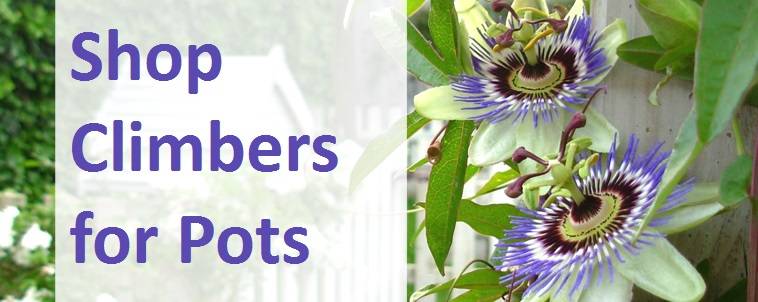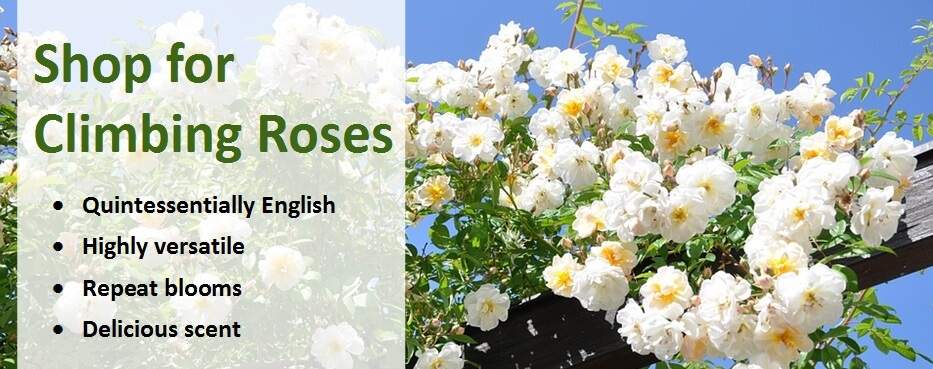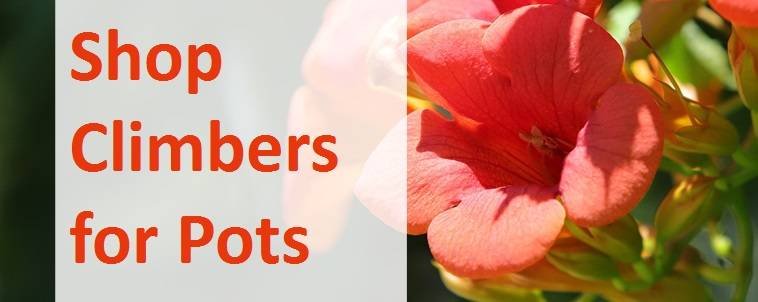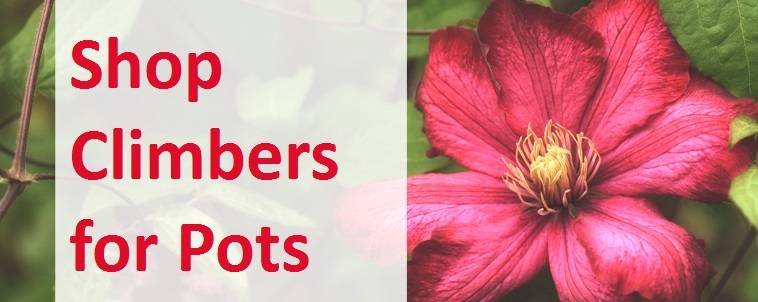Best Climbing Plants for Growing in Pots and Containers
Container-grown climbers are highly versatile, adding another dimension to the garden, softening hard lines and providing a flush of colour and interest. They are perfect for adding ascent to patios and even balconies or giving that extra bit of privacy from nosey neighbours. Most climbers can be grown in containers but some are better suited than others and some are appropriate but only with a very large pot. Compact forms of Clematis and Lonicera are the most common choices for very good reason, but there are plenty more.
Climbing Plants for Small to Medium Sized Containers
1) Clematis
- Clematis are one of the most popular climbers with distinctive flowers in a range of colour including reds, purples, blues, pinks and whites. They prefer sun or partial shade, are mostly fully hardy and generally quite easy to grow.
- Small-growing clematis are a good choice for container growing as they will stay compact and flower when young. Consider combining 2 complimentary coloured varieties in the same pot for a striking floral display.
- Clematis are divided into 3 main groups which determine how they should be grown:
- Group 1 - early flowering Clematis blooming on previous year's growth in winter or spring. Prefer a sunny, sheltered position with little or no pruning and include most evergreen clematis.
- Group 2 - deciduous Clematis which produce large, showy flowers either on previous year's growth in late spring and early summer or the current season's growth in mid to late summer.
- Group 3 - mixed group of late flowering and herbaceous Clematis which die back to the ground in winter. Includes varieties with large, showy flowers and smaller-flowered fragrant Clematis.
- Plant deciduous clematis with the root ball 5-8cm (2-3 inches) below the soil surface to encourage new shoots to develop from below ground and help provide protection if they're hit by clematis wilt. Evergreen varieties such as Clematis Armandii should be planted with the crown at soil level like most other climbers.
- Clematis climb by twisting their leaf stalks around supports so it is necessary to provide some form of support. You can do this by attaching or embedding a support such as a trellis into your container, or positioning your container next to a wall or fence with horizontal wires installed.
Recommended Group 2 Clematis for Containers
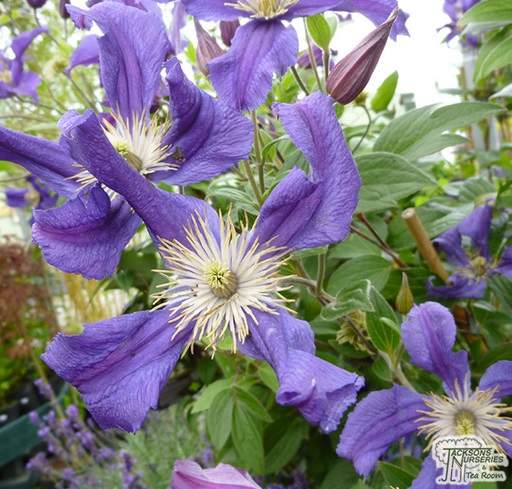
Recommended Group 3 Clematis for Containers
Clematis 'Madame Julia Correvon'
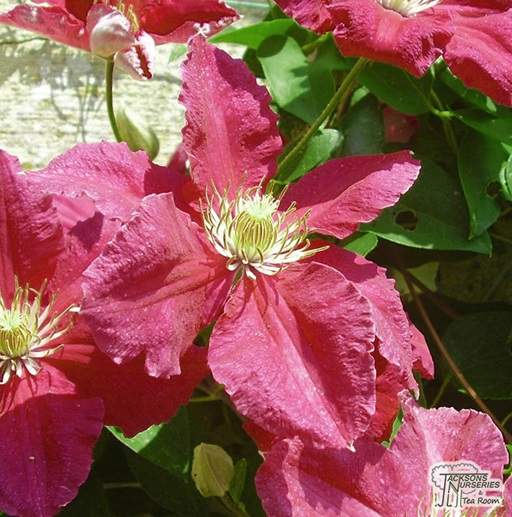
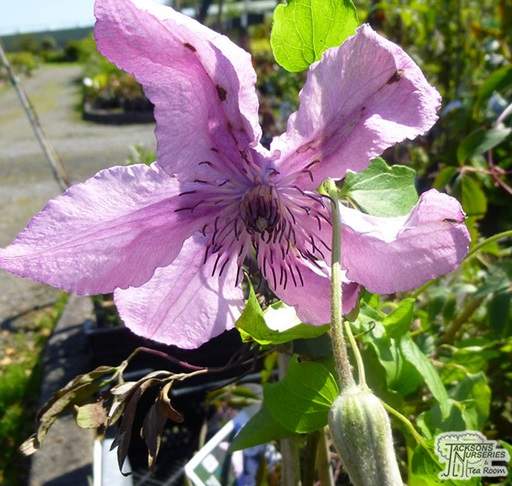
2) Lonicera (Honeysuckle)
- Lonicera are another popular climber with sweetly scented summer flowers held in attractive clusters. They're easy to grow, ideally in a spot where their roots will be in the shade with upper growth in the sun.
- Lonicera x Caprilia Ever 'Inov42' is a compact honeysuckle producing beautiful small clusters of scented flowers with lilac buds opening to orange-yellow in the summer. These are followed by dark blue fruits that persist through autumn and winter, providing a valuable food source for wildlife.
- Lonicera periclymenum 'Scentsation' is a more recent addition to the native honeysuckle varieties with large showy clusters of beautifully perfumed ivory and golden yellow flowers in late spring to early summer. These are followed by red berries that are attractive to small birds.
- Lonicera fragrantissima also known as winter honeysuckle, is a deciduous/semi-evergreen climbing shrub ideal for brightening up your garden in winter and early spring. Fragrant, creamy-white flowers appear on almost leafless branches, and are sometimes followed by dull red berries.
- Lonicera x brownii 'Dropmore Scarlet' produces beautiful, small fragrant clusters of orange-red tubular flowers with bright orange throats in summer. The flowers are unscented but their vivid colour makes up for it with a beautiful display, and are followed by orange berries in the autumn.
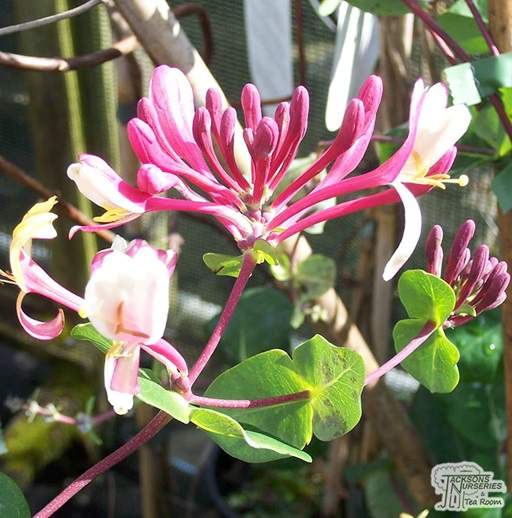
Lonicera x brownii 'Dropmore Scarlet'
3) Passion Flower
- For a truly exotic display look no further than the passion flower (Passiflora caerulea), providing you're able to position it in a warm part of the garden and reliably provide frost protection.
- The passion flower is a truly unique climber with dark green leaves accompanied with fragrant white flowers, flushed with purple blue and pink shades, varying on individual leaflets around a central display of purple tinged filaments. When grown in a sheltered area it also produces orange-yellow egg-shaped fruit.
- Ideal for a tropical planting scheme in milder parts of the country. An alternative to growing passion flower permanently in the border is to 'plung' a container-grown specimen into the ground in the border over the summer, then lift the container our of the ground for over-wintering in frost-free conditions.
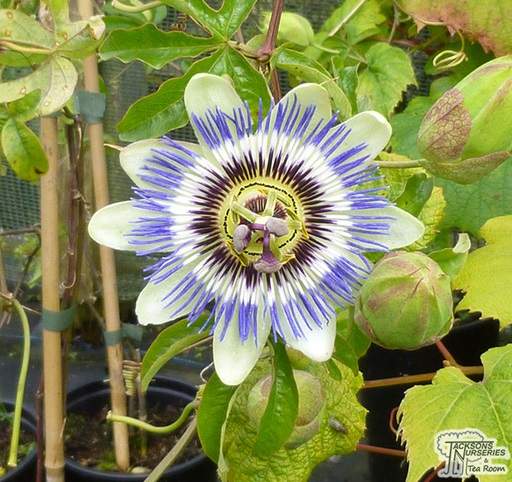
4) Rosa 'Gertrude Jekyll'
- A climbing rose is the first choice for many people as they'll produce an abundance of sweetly scented blooms. Whilst this is true, most roses are only suitable for very tall containers because their deep tap roots make them unsuitable for more conventional sized pots.
- If you really want to container grow a climbing rose, we recommend Rose 'Gertrude Jekyll' because of its more compact growth habit, although it will need lots of watering to keep it happy.
- 'Gertrude Jekyll' produces large, fully double, cup-shaped, glowing deep pink blooms which emerge from fat, eye-catching buds between July and September, releasing an outstanding, old fashioned damask fragrance as they open and good for cutting. A vigorous, healthy grower with greyish-mid-green leaves.
- Remove spent flowers to encourage a second flush of colour and maintain a neat appearance.
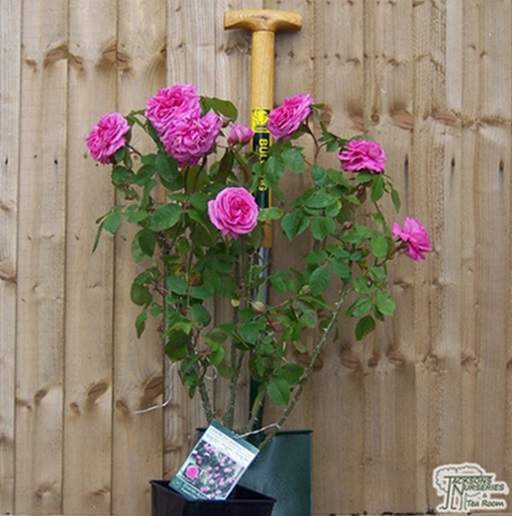
Very Large Containers
For these you'll need a really big container and very sturdy trellis or support structure:
5) Ivy
- English ivy, also known as Hedera helix or branching ivy, is a self-clinging climber which spreads rapidly by aerial roots, without requiring a support structure once established.
- It's great for covering a large wall area very quickly and creating a homely, cottage feel but also looks stunning cascading over the side of a container or hanging basket alongside colourful annuals.
- Ivy is an unfussy grower that will succeed in anything from full shade to full sun and is able to withstand periods of drought. It is also pest and disease resistant and fully hardy, although remember that plants in containers do not always survive cold temperatures as well as the same variety planted in the ground.
- Just be aware that it can become invasive and will drown out everything in its path if you're not careful, so keep it away from other container grown plants to prevent it from taking over and killing them.
- Hedera helix 'Glacier' is an excellent evergreen ivy grown for its foliage with grey-green leaves and silver and cream variegation. Mature plants produce yellow-green flowers in autumn, followed by black fruits. Good for attracting wildlife such as birds and insects to the garden.
- Hedera algeriensis 'Gloire de Marengo' is a vigorous, self-clinging, evergreen climber with bright, glossy variegated large green leaves and smooth, deep red leaf stalks. The variegated leaves can be used to great effect to brighten up a dark corner, but avoid total shade as the light brings out the variegation. Requires a well-drained, acidic soil in a sheltered site protected from cold winds.
- Hedera colchica 'Dentata Variegata' is a vigorous, self-clinging, evergreen climber with large, mottled grey-green leaves edged with cream. The variegated leaves can be used to great effect to brighten up a dark corner, but avoid total shade, as the light brings out the variegation.
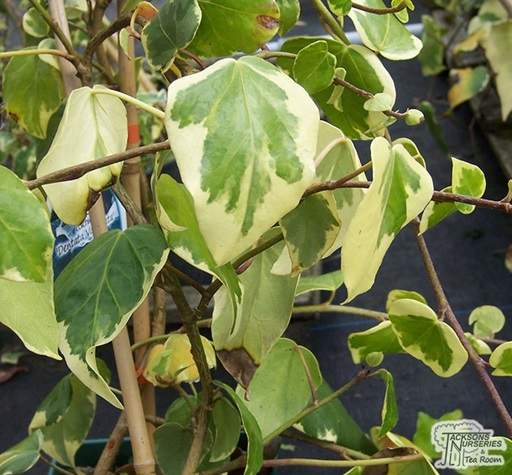
- Hedera colchica 'Sulphur Heart' is a large leaved variegated evergreen ivy that has gold and lime green variegations that are superb for bringing splashes of light to a dark, shady wall. The variegation gets brighter as the plant grows older, contrasting well with Jasminum nudiflorum & Cotoneaster horizontalis.
- Hedera helix 'Green Ripple' - Angular striking vivid green leaves with contrast pale green veins. A superb evergreen Ivy for cascading over the side of a container or covering low walls and banks.
- Hedera helix 'Goldheart' is wonderful, evergreen climber that has lustrous, glossy dark green leaves with impressive, bright golden-yellow centres and tapering edges. In the autumn it bears clusters of small, yellowish-green flowers followed by attractive, spherical black fruit.
- Hedera hibernica has glossy, dark green leaves which are very effective for hiding unsightly objects. It will thrive in any soil type and can be trimmed at any time of the year. Those with sensitive skin should be careful when handling it as the sap can be irritating.
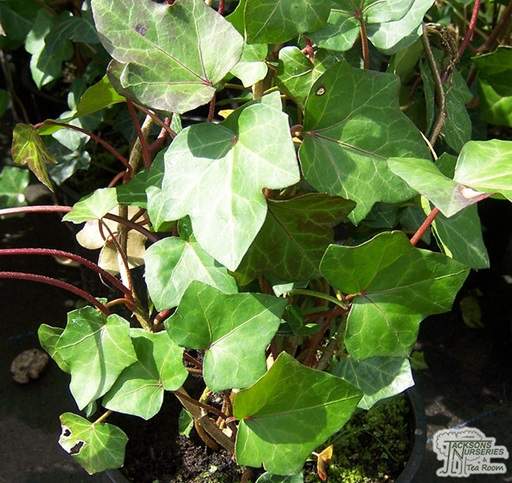
6) Virginia Creeper
- Virginia Creeper has large, bright green leaves that turn deep crimson, delivering beautiful autumn foliage colours. It is easy to grow, tough and unfussy - thriving in sun or shade and reasonably drought tolerant.
- When grown in the border it can be fast-growing and become invasive when mature, spreading by self-clinging aerial roots. It will naturally grow more slowly within the constraints of a container but you should still be prepared to keep it in check.
- Similar to ivy, avoid growing it too close to other plants so it can spread without drowning out the competition. It may need to be lifted and re-planted in fresh compost every few years.
- Prune using shears to prevent Virginia creeper from taking over unwanted spaces where its not wanted, like windows and lofts. Spring is the best time to prune but don't put it off if required to control growth.
- Parthenocissus henryana is a most colourful deciduous Virginia creeper with deep green leaves, often with green-bronze hues and pinkie white veins. Leaves consist of 3-5 leaflets that turn fiery orange-red in autumn. Small, dark berries are produced in autumn, contrasting beautifully with the reddish foliage. Less vigorous than Parthenocissus quinquefolia, it is ideally suited for smaller gardens and will quickly cover any unsightly areas you need covering. It can even be grown on a tricky north-facing wall.
- Parthenocissus quinquefolia is an easy to grow, self clinging deciduous climber with dark green leaves that turn fiery crimson-red in autumn, especially if grown in shade. These are often followed by purple berries which are much loved by birds during the colder months. Excellent wall covering that provides a stunning display in either full sun or shade, however the autumnal colours are best in dappled shade. Very vigorous so requires a lot of space and regular pruning to keep it in check.
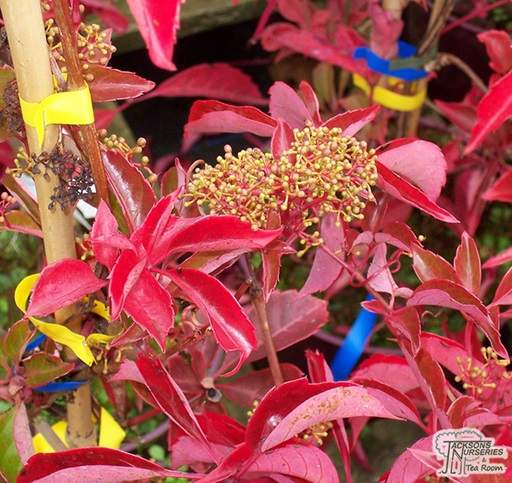
7) Trumpet Vine (Campsis)
- Campsis is a perennial vine famed for its exotic-looking trumpet shaped flowers produced in shades spanning reds, orange and yellows all summer long and into the autumn. It flowers most prolifically when grown in a sunny spot, ideal for attracting wildlife such as hummingbirds to the garden.
- It spreads via self-clinging aerial roots, meaning it will not require a support structure once initial training is complete. Trumpet vine is fast growing and will quickly cover unsightly walls or fences, but it can become invasive when mature so needs to be regularly kept in check to prevent it from spreading to unwanted parts of your home and garden.
- The best time to prune is spring or autumn, but don't put it off if required to keep growth under control. If allowed to take over, Campsis can be very difficult to get rid of. Water only as needed and do not fertilise.
- The woody vines are usually strong enough to endure winter while other growth may die back in cooler parts of the UK, returning again in spring.
- Campsis radicans bears masses of beautiful, trumpet-shaped, orange-red blooms produced at branch ends all summer long. As the weather cools, the foliage mellows to yellow-green and blooms give way to pod-like capsules of winged seeds.
- Campsis radicans f. flava boasts exotic, rich yellow trumpet-shaped flowers all summer long. These are borne in pendulous clusters above long, coarsely toothed, glossy dark-green leaves with pointed tips and distinctive veining.
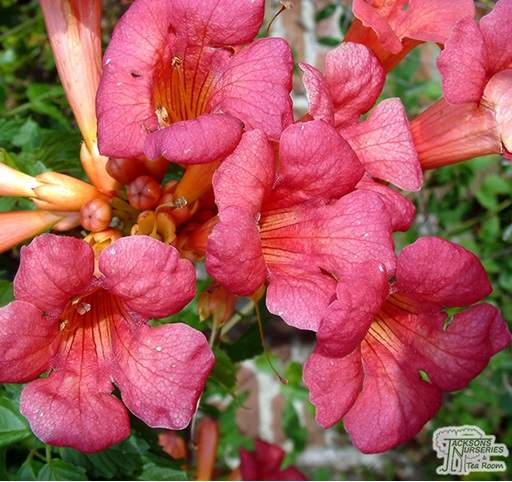
8) Climbing Hydrangea
- Climbing hydrangea produce clusters of dainty white flowers throughout the summer. Slow growing at first, becoming faster growing with age, they will thrive even in shady, inhospitable parts of the garden.
- Spreading by self-clinging aerial roots, climbing hydrangeas have oval, almost heart shaped, dark green leaves, turning a rich yellow and delivering beautiful autumn foliage colours.
- It's important to keep climbing hydrangeas well watered until they are established. They flower on the previous season's wood, so if you need to prune them back this must be done in late autumn or early spring to avoid restricting the flowering display in the following year.
- Hydrangea anomala subsp. petiolaris is a valuable, fully hardy strong-growing deciduous climber reaching up to 15 metres (0.5-1 metres of annual growth). Gorgeous flowers of greenish-white with several large, prominent white florets along the margin. Green, ovate leaves on long petioles turn to yellow in autumn and the stems appear copper brown with peeling bark.
- Hydrangea seemannii is an evergreen climber with dark, leathery leaves, an invaluable edition to any garden. Clinging to walls or fences with aerial roots, the greeny-white lacecap flowers erupt in summer and last well into autumn, providing a beautiful display. It grows best in a sunny position, sheltered from any harsh winter weathers. They are not fully hardy so may require some winter protection in order to maintain an evergreen appearance.
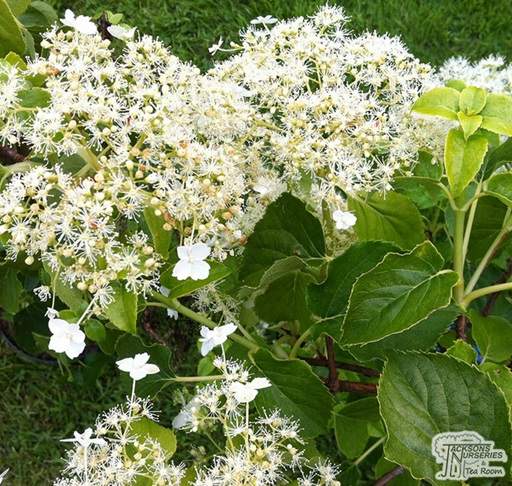
Quick Care Tips
- Container grown climbers rely on you to give them everything they need.
- Keep well watered, especially on hot summer days, and fertilise smaller-growing varieties regularly.
- Replace the top 2.5-5cm (1–2in) layer of soil each spring with fresh potting compost.
- Protect your containers from freezing in the winter by insulating with a few layers of bubble wrap.
Share this page:

